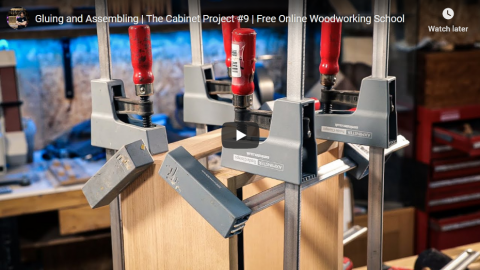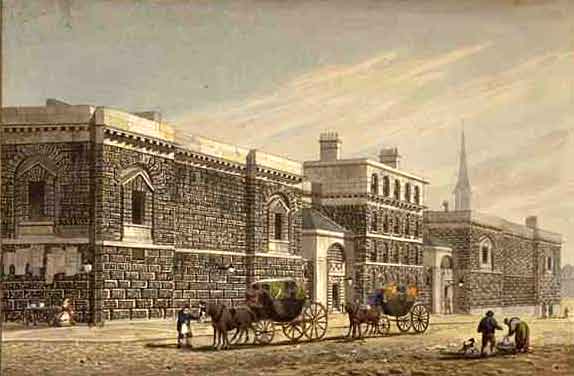Matt Estlea
Published 2 Apr 2020In this part of the project, I show you how to conduct a dry assembly to ensure the carcass will go together properly. As well as talk you through how to spot and amend potential issues you may face.
See the full lesson here:
https://mattestlea.com/free-online-wo…Plans for this project:
https://mattestlea.com/product/cabine…Buy Pre-Planed Material Packs for this Project Here:
www.mattestlea.com/projectpacks_________________________________________________________________
Support what I do by becoming a Patron! This will help fund new tools, equipment and cover my overheads. Meaning I can continue to bring you regular, high quality, free content. Thank you so much for your support! https://www.patreon.com/mattestlea
Don’t want to commit to a monthly direct debit but still want to help out? That’s fine!
You can make a one time donation here: www.mattestlea.com/donate
You can donate us biscuits here: www.mattestlea.com/wishlist
_________________________________________________________________
BUY THE WOODWORKING BIBLE HERE:
www.mattestlea.com/the-woodworkers-manual
_________________________________________________________________SOCIAL MEDIA
Instagram: www.instagram.com/mattestlea
Twitter: www.twitter.com/mattestlea
Patreon: www.patreon.com/mattestlea
Pinterest: www.pinterest.com/mattestlea
LinkedIn: www.linkedin.com/in/matt-estlea-b6414b11a/
_________________________________________________________________
See what tools I use here: www.mattestlea.com/equipment
My Website: www.mattestlea.com
_________________________________________________________________My name is Matt Estlea, I’m a 24 year old Woodworker from Basingstoke in England and my aim is to make your woodworking less s***.
I come from 5 years tuition at Rycotewood Furniture Centre with a further 1 year working as an Artist in Residence at the Sylva Foundation. I now teach City and Guilds Furniture Making at Rycotewood as of September 2018.
If you’re interested in studying at Rycotewood, view their courses here:
www.mattestlea.com/rycotewoodI also had 5 years of experience working at Axminster Tools and Machinery where I helped customers with purchasing tools, demonstrated in stores and events, and gained extensive knowledge about a variety of tools and brands. I discontinued this at the start of 2019 to focus solely on video creation and teaching.
During the week, I film woodworking projects, tutorials, reviews and a viewer favourite ‘Tool Duel’ where I compare two competitive manufacturers tools against one another to find out which is best. I also have a Free Online Woodworking School which you should definitely check out!
www.mattestlea.com/school
I like to have a laugh and my videos are quite fast paced BUT you will learn a lot, I assure you.
Lets go make a mess.
April 4, 2020
Gluing and Assembling | The Cabinet Project #9 | Free Online Woodworking School
The media’s grasp of modern logistics
Kurt Schlicter — who, spoiler, isn’t a fan of our news media in general — on the demands by newsbeings for the impossible to be done immediately:
We Americans are truly blessed by having a mainstream media full of brilliant renaissance men, women, and gender non-specific entities who are masters of so many varied and intermittently useful skills and who are eager to share their knowledge with us benighted souls. The pandemic has revealed that every urban Twitter blue check scribbler, MSNBCNN panelist, NYT/WaPo doofus, and barely legal “senior editor” of a website you never heard of, is a Nobel Prize-winning epidemiologist, a master logistician, and a diversity consultant to boot.
[…]
Another hitherto unknown skill that the media believes it possesses is logistics. “Why hasn’t Trump commanded a million ventilators to appear?!” the reporters demand. It’s pretty easy to see where they might have gotten the idea that the moment one articulates a desire to possess something that it magically appears. Capitalism has pretty much made that a reality. If you want something, you can go to a store and get it 24/7, or you can go on Amazon and it’ll be at your Manhattan apartment in 48 hours. Since they have never built anything or transported anything or distributed anything, only benefited from the labor of the unhip people who do those things, it’s only natural that the delayed adolescents who make up our media class imagine that material goods can be simply wished into being. After all, for all practical purposes during normal times, because of the efforts of Americans they look down upon, material goods pretty much can be simply wished into being. But prosperity takes work, not that the media would know.
[…]
Apparently, the media class thinks there are giant warehouses with an endless supply of goods just sitting there, somewhere, waiting. They have no idea about how logistics work, how goods flow quickly from producer to market and how expected resupply levels need a few days to adjust from a 10 percent daily turnover to a 30 percent daily turnover. They have zero appreciation for inventory management because no one they know does unglamorous stuff like that.
It’s all much easier in a socialist command economy. You get nothing and like it. Or don’t like it. Whatever. Here’s your weekly bean allowance. Workers of the world unite. You have nothing to lose but access to toothpaste and toilet paper.
The best part is when the media – the same media that was collectively soiling its Dockers because that mean old Trump was barring direct flights from China because of racism and stuff – demands to know why, back in December, Trump was not commanding a zillion Wuhan Flu tests, a zillion masks, and a zillion ventilators be created, while locking down all of America. Leaving aside the whole lack of an enumerated power to do that thing, in what world would have Trump have convinced anyone – least of all the media that was slobbering over his bogus impeachment at the time – that some bat soup-derived pathogen in BumFoo, China, was going to black swan all over America’s economy? The lack of seriousness by the people who presume to be reporting the news to us is more breathtaking than the damn ChiCom grippe.
“Into The Fire” – The Vietnam War – Sabaton History 061 [Official]
Sabaton History
Published 3 Apr 2020During the height of the Cold War, weapons ran hot in the jungles of Vietnam. Combat along the overgrown trails, the wide open fields of rice-paddies or the marshes of the Mekong Delta, was not only exhausting and relentless, but also the place where many of the old doctrines of warfare did no longer apply. The western coalition had to face the elusive guerilla methods of the North Vietnamese forces, who prepared ambushes and traps along the marching routes. The eerie quietness of the jungle was all too often broken by a sudden explosion of violence as troops marched right into the fire.
Support Sabaton History on Patreon: https://www.patreon.com/sabatonhistory
We would like to thank the World of Tanks team for their contribution and help with the video filming. If you’re not yet a World of Tanks player, join the game and get your hands on cool in-game stuff for free via the link: https://redir.wargaming.net/w7fwclmx/…
Listen to “Into the Fire” on the album Primo Victoria:
CD: http://bit.ly/PrimoVictoriaStore
Spotify: http://bit.ly/PrimoVictoriaSpotify
Apple Music: http://bit.ly/PrimoVictoriaAppleMusic
iTunes: http://bit.ly/PrimoVictoriaiTunes
Amazon: http://bit.ly/PrimoVictoriaAmzn
Google Play: http://bit.ly/PrimoVictoriaGooglePlayCheck out the trailer for Sabaton’s new album The Great War right here: https://www.youtube.com/watch?v=HCZP1…
Listen to Sabaton on Spotify: http://smarturl.it/SabatonSpotify
Official Sabaton Merchandise Shop: http://bit.ly/SabatonOfficialShopHosted by: Indy Neidell
Written by: Markus Linke and Indy Neidell
Directed by: Astrid Deinhard and Wieke Kapteijns
Produced by: Pär Sundström, Astrid Deinhard and Spartacus Olsson
Creative Producer: Joram Appel
Executive Producers: Pär Sundström, Joakim Broden, Tomas Sunmo, Indy Neidell, Astrid Deinhard, and Spartacus Olsson
Post-Production Director: Wieke Kapteijns
Edited by: Iryna Dulka
Sound Editing by: Marek Kaminski
Maps by: Eastory – https://www.youtube.com/c/eastoryArchive by: Reuters/Screenocean https://www.screenocean.com
Music by Sabaton.An OnLion Entertainment GmbH and Raging Beaver Publishing AB co-Production.
© Raging Beaver Publishing AB, 2019 – all rights reserved.
Eighteenth century health improvements through “ventilators”
In the latest Age of Invention newsletter, Anton Howes relates how a mistaken belief still led to a significant improvement in health:
One of the most worrying diseases of the mid-eighteenth century was typhus. We now know that it is spread by lice or fleas, but at the time, like so many other diseases, it was thought to be caused by noxious air — “malaria”, for example, literally means “bad air”. This was not a silly theory. It was based on empirical observation, which perhaps explains why the belief in such noxious miasmas persisted for so long — well into the late nineteenth century, if not the early twentieth, before finally being ousted by germ theory. Our ancestors were not stupid, no matter how strange their beliefs might appear in hindsight. (Also take alchemy, or the belief that some animals spontaneously generated.)
The Central Tower of the Palace of Westminster is actually a disguised ventilator.
Photo by Cary Bass via Wikimedia Commons.Typhus fit the miasma theory especially well because it frequently appeared in confined spaces, like ships’ holds, prisons, mines, workhouses, and hospitals. The disease was thus often called “gaol fever”, or “hospital fever”. And there was the fact that at least one of the solutions designed to combat miasmas, the ventilator, actually seemed to work. This ventilator was not the kind that is in such high demand right now, used to help feed oxygen into patients’ lungs, but instead a machine used to get the air flowing in and out of confined spaces — like a 1740s air-conditioning unit.
At first glance, removing the stale air from a space shouldn’t do anything against typhus. But mortality declined drastically in the prisons and ships to which the ventilator was introduced. It halved the number of deaths per year in Newgate prison, where the bellows-like machinery was powered by a windmill, and the inmates of the Savoy prison fared even better. On ships, too, mortality declined among mariners, passengers, soldiers, and especially among the group that suffered most from long voyages across the eighteenth-century Atlantic: slaves.
But it’s not clear exactly why. After all, the ventilator did not kill the typhus-ridden lice or fleas. I have a few theories as to what must have been going on. Perhaps, by improving the supply of oxygen to confined spaces, people’s bodies were simply better served to deal with all manner of diseases. Surgeons aboard slave ships sometimes noted that, without proper ventilation, many slaves would simply die in the night of suffocation. Or perhaps the ventilator’s effectiveness had something to do with its drying effect. The machine was used to prevent grain stores from becoming humid, thus staving off damp-loving weevils. The ventilators might thus have staved off typhus through a similar means: although I’m not so certain about body lice, humid conditions are preferred by fleas. Regardless of the real reasons, the ventilators worked, and even when they did not reduce mortality, they made confined spaces more bearable for those who had to endure them. Ship captains reported that they did not even have to force their sailors to pump the ventilator’s bellows, because they liked the cool air so much. Ventilators were soon installed in the House of Commons, and in many of London’s theatres.
From the Wikipedia entry on architectural ventilation:
The development of forced ventilation was spurred by the common belief in the late 18th and early 19th century in the miasma theory of disease, where stagnant ‘airs’ were thought to spread illness. An early method of ventilation was the use of a ventilating fire near an air vent which would forcibly cause the air in the building to circulate. English engineer John Theophilus Desaguliers provided an early example of this, when he installed ventilating fires in the air tubes on the roof of the House of Commons. Starting with the Covent Garden Theatre, gas burning chandeliers on the ceiling were often specially designed to perform a ventilating role.
Mechanical systems
A more sophisticated system involving the use of mechanical equipment to circulate the air was developed in the mid 19th century. A basic system of bellows was put in place to ventilate Newgate Prison and outlying buildings, by the engineer Stephen Hales in the mid-1700s. The problem with these early devices was that they required constant human labour to operate. David Boswell Reid was called to testify before a Parliamentary committee on proposed architectural designs for the new House of Commons, after the old one burned down in a fire in 1834. In January 1840 Reid was appointed by the committee for the House of Lords dealing with the construction of the replacement for the Houses of Parliament. The post was in the capacity of ventilation engineer, in effect; and with its creation there began a long series of quarrels between Reid and Charles Barry, the architect.Reid advocated the installation of a very advanced ventilation system in the new House. His design had air being drawn into an underground chamber, where it would undergo either heating or cooling. It would then ascend into the chamber through thousands of small holes drilled into the floor, and would be extracted through the ceiling by a special ventilation fire within a great stack.
Reid’s reputation was made by his work in Westminster.
Monetary Policy: The Negative Real Shock Dilemma
Marginal Revolution University
Published 15 Aug 2017Imagine a negative real shock, like an oil crisis, just hit the economy. How should the Fed respond?
Decreasing the money supply will help with inflation, but make growth worse. Increasing the money supply will improve growth, but inflation will climb higher. What’s the Fed to do?!
QotD: The danger of studying philosophy
I quickly learned that […] many of my professors valued paradoxical and obscure arguments. And I got pretty good at making them. In an essay on Wallace Stevens, I concluded by asserting, “If everything is nothing, then that nothingness is everything. For poetry to encompass one, it encompasses the other. When Stevens’s mind of winter descends into the inescapable nothingness of his subjectivity, he has claimed for himself the totality of everything.” I don’t know what this means. But I wrote it and I was rewarded for it.
I knew my analysis of Wallace Stevens would please my professor, but I was bothered by a nagging thought that I really didn’t understand Wallace Stevens. I wondered if my graduate school training just amounted to a parlor trick. Last year, at my high school, the students enjoyed arguing if a hotdog is a sandwich, the millennial equivalent of asking how many angels can dance on the head of a pin. The hotdog question made its way to the whiteboard in our staff lounge. By the time I arrived, my colleagues had written their responses. Some argued that a hot dog is not a sandwich because a sandwich requires two pieces of bread and a hotdog bun isn’t supposed to separate. Others averred that it most definitely is a sandwich: Meat between bread is a sandwich, end of story. I saw these responses and thought, “Simpletons!” before putting my graduate education to work: “In order to determine if a ‘hotdog is a sandwich,’ we must first determine the proper understanding of ‘is’ for if we do not grasp the ontological necessity of being itself, we fall into an abyss wherein ‘being’ is and is not itself and thus a hotdog is and is not a sandwich for it is and is not its very self.” I was quite amused by the whole situation until a colleague told me that a student had seen the whiteboard and said he wanted to study philosophy so that he could write like me.
S. A. Dance, “Incomprehension 501: Intro to Graduate School”, Quillette, 2018-03-06.








